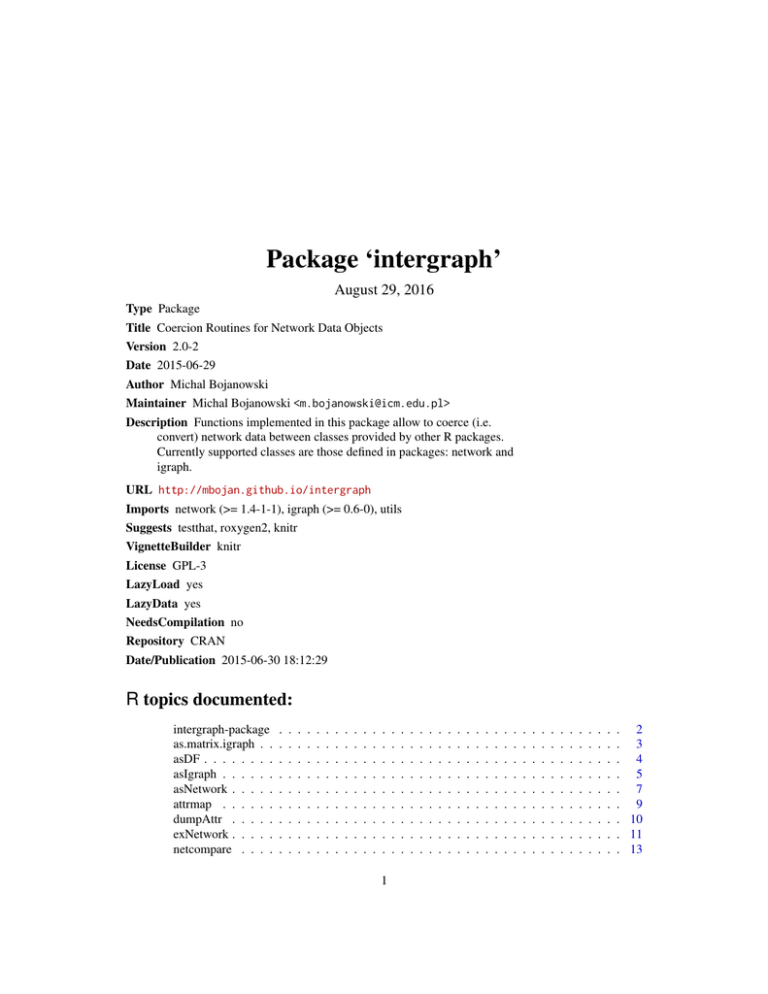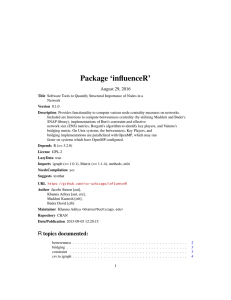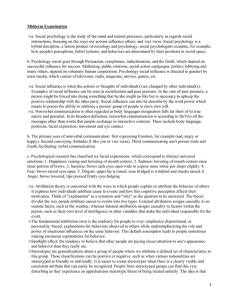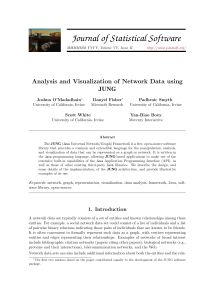Package `intergraph`
Anuncio

Package ‘intergraph’ August 29, 2016 Type Package Title Coercion Routines for Network Data Objects Version 2.0-2 Date 2015-06-29 Author Michal Bojanowski Maintainer Michal Bojanowski <[email protected]> Description Functions implemented in this package allow to coerce (i.e. convert) network data between classes provided by other R packages. Currently supported classes are those defined in packages: network and igraph. URL http://mbojan.github.io/intergraph Imports network (>= 1.4-1-1), igraph (>= 0.6-0), utils Suggests testthat, roxygen2, knitr VignetteBuilder knitr License GPL-3 LazyLoad yes LazyData yes NeedsCompilation no Repository CRAN Date/Publication 2015-06-30 18:12:29 R topics documented: intergraph-package as.matrix.igraph . . asDF . . . . . . . . asIgraph . . . . . . asNetwork . . . . . attrmap . . . . . . dumpAttr . . . . . exNetwork . . . . . netcompare . . . . . . . . . . . . . . . . . . . . . . . . . . . . . . . . . . . . . . . . . . . . . . . . . . . . . . . . . . . . . . . . . . . . . . . . . . . . . . . . . . . . . . . . . . . . . . . . . . . . . . . . . . . . . . . . 1 . . . . . . . . . . . . . . . . . . . . . . . . . . . . . . . . . . . . . . . . . . . . . . . . . . . . . . . . . . . . . . . . . . . . . . . . . . . . . . . . . . . . . . . . . . . . . . . . . . . . . . . . . . . . . . . . . . . . . . . . . . . . . . . . . . . . . . . . . . . . . . . . . . . . . . . . . . . . . . . . . . . . . . . . . . . . . . . . . . . . . . . . . . . . . . . . . . . . . . . . . . . . . . . . . . . . . . . . . 2 . 3 . 4 . 5 . 7 . 9 . 10 . 11 . 13 2 intergraph-package Index 15 intergraph-package Coercion Routines for Network Data Objects Description This package contains methods for coercion between various classes used to represent network data in R. Details Functions implemented in this package allow to coerce (i.e. convert) network data between classes provided by other R packages. Currently supported classes are: "network" from package network, "igraph" from package igraph. The main functions are: • asNetwork and its methods to create objects of class "network". • asIgraph and its methods to create objects of class "igraph". See their help pages for more information and examples. As all the supported packages are written using S3 methods, so are the methods in this package. If you find this package useful in your work please cite it. Type citation(package="intergraph") for the information how to do that. Author(s) Written and maintained by Michal Bojanowski <[email protected]>. Examples # example of converting objects between classes 'network' and 'igraph' # needs packages igraph and network attached if( require(network) & require(igraph) ) { ### convert 'network' -> 'igraph' # example network as object of class "network" summary(exNetwork) # convert to class "igraph" g <- asIgraph(exNetwork) # check if 'exNetwork' and 'g' are the same # (dropping some aux attributes) all.equal( structure(as.matrix(exNetwork, "edgelist"), n=NULL, vnames=NULL), igraph::get.edgelist(g) ) as.matrix.igraph 3 # compare results using 'netcompare' netcompare(exNetwork, g) ### convert 'igraph' -> 'network' # example network as object of class "igraph" summary(exIgraph) # convert to class "network" gg <- asNetwork(exIgraph) } # check if they are the same # (dropping some attributes) all.equal( get.edgelist(exIgraph), structure(as.matrix(gg, "edgelist"), n=NULL, vnames=NULL)) netcompare(exIgraph, gg) as.matrix.igraph Convert igraph objects to adjacency or edge list matrices Description Get adjacency or edgelist representation of the network stored as igraph object. Usage ## S3 method for class 'igraph' as.matrix(x, matrix.type = c("adjacency", "edgelist"), attrname = NULL, sparse = FALSE, ...) Arguments x object of class igraph, the network matrix.type character, type of matrix to return, currently "adjacency" or "edgelist" are supported attrname character, name of the edge attribute to use to fill in the cells of the adjacency matrix sparse logical, whether to return a sparse matrix ... other arguments to/from other methods Details If matrix.type is "edgelist" a two-column numeric edgelist matrix is returned. The value of attrname is ignored. 4 asDF If matrix.type is "adjacency" then a square adjacency matrix is returned. If attrname is NULL (default) the matrix is binary. Otherwise attrname can be a name of edge attribute of x. In that case the cells of the results are the values of that attribute. Other arguments passed through ... are passed to either get.adjacency or get.edgelist depending on the value of matrix.type. Value Depending on the value of matrix.type either a square adjacency matrix or a two-column numeric matrix representing the edgelist. See Also get.adjacency, get.edgelist Examples data(exIgraph) as.matrix(exIgraph, "adjacency") as.matrix(exIgraph, "edgelist") # use edge attribute "label" as.matrix(exIgraph, "adjacency", sparse=FALSE, attr="label") asDF Convert network to data frame(s) Description Convert a network data object to, possibly two, data frames: a data frame with an edge list with edge attributes (if any), and a data frame of vertexes with vertex attributes (if any). This is a generic function, see below for available methods. Usage asDF(object, ...) ## S3 method for class 'network' asDF(object, ...) ## S3 method for class 'igraph' asDF(object, ...) Arguments object R object representing a network, see below for available methods ... other arguments passed to/from other methods asIgraph 5 Details Currently there are methods for object being in one of the following classes: "network", "igraph". The function first gets the graph edge list using the appropriate function depending on the class of object (see below). Edge attributes, if any, are then extracted using dumpAttr and added to it. The vertex data frame is constructed with a vertex id as a sequence of integer numbers. Details are method-specific, see below. Vertex attributes are extracted with dumpAttr and added to this data frame. Method-specific notes: For objects of class "network". Objects of this class store the vertex ids as integer numbers. There is also an attribute "vertex.names" which is always created when using graph constructors provided in the package network. asDF adds "vertex.names" to the vertex data frame as a normal attribute and does not use it as a vertex id in the edge list. The edge list is created using as.matrix.network function and contains integer vertex ids. Objects of class "igraph", as provided by the igraph package. Vertex ids in these objects integers starting from 1 (in igraph version prior to 0.6-0 vertex ids started from 0). However, it is also possible to provide a vertex attribute "name". It is added to the vertex data frame as a normal vertex attribute and is not used on the edge list data frame. The edge list is created using get.edgelist function with argument names set to FALSE so that integer vertex ids are used. Value List with two components: edges containing an edge list data frame at first two columns and edge attributes on further ones. vertexes with vertex id in the first column, named id and any vertex attributes in the other columns. Examples # using method for 'network' objects d1 <- asDF(exNetwork) str(d1) # using method for 'igraph' objects d2 <- asDF(exIgraph) str(d2) asIgraph Coerce an object to class "igraph" Description Coerce objects to class "igraph". 6 asIgraph Usage asIgraph(x, ...) ## S3 method for class 'network' asIgraph(x, amap = attrmap(), ...) ## S3 method for class 'data.frame' asIgraph(x, directed = TRUE, vertices = NULL, vnames = NULL, ...) Arguments x R object to be converted amap data.frame with attribute copy/rename rules, see attrmap directed logical, whether the created network should be directed vertices NULL or data frame, optional data frame containing vertex attributes vnames character, name of the column in vertices to be used as a name vertex attribute, if NULL no vertex names are created ... other arguments from/to other methods Details asIgraph is a generic function with methods written for data frames and objects of class "network". If x is a data frame, the method used is a wrapper around graph.data.frame in package igraph. The vnames argument was added so that the user can specify which vertex attribute from the data frame supplied through vertices argument is used for vertex names (the name attribute in igraph objects) in the returned result. By default the vertex names are not created. If x is of class "network" (package network) the function uses asDF to extract data on edges and vertex with their attributes (if present). Network attributes are extracted as well. Not all vertex/edge/network attributes are worth preserving though. Attributes are copied, dropped or renamed based on rules given in the amap argument, see attrmap for details. The function currently does not support objects that represent neither bipartite networks nor hypergraphs. Value Object of class "igraph". See Also graph.data.frame Examples ### using 'asIgraph' on objects of class 'network' g <- asIgraph(exNetwork) asNetwork 7 # compare adjacency matrices netmat <- as.matrix(exNetwork, "adjacency") imat <- as.matrix(g, "adjacency") # drop the dimnames in 'netmat' dimnames(netmat) <- NULL # compare identical( netmat, imat ) ### using 'asIgraph' on data.frames # data frame with vertex ids and vertex attributes v <- 1:4 vd <- data.frame(id = v + 5, label=letters[1:4]) print(vd) # edge list (first two columns) and edge attributes e <- c(1,2, 2,3, 3,4, 4,1) ed <- data.frame(id1 = e[seq(1,8, by=2)]+5, id2=e[seq(2, 8, by=2)]+5, a=letters[1:4]) print(ed) # build the network # without vertex attributes g <- asIgraph(ed, directed=FALSE) # with vertex attributes gv <- asIgraph(ed, vertices=vd, directed=FALSE) # NOTE: Even though vertex ids start at 6 the network has 4 nodes: range(vd$id) # min and max of node ids if(require(igraph)) igraph::vcount(gv) # number of nodes in 'gv' asNetwork Convert objects to class "network" Description Convert objects to class "network" Usage asNetwork(x, ...) ## S3 method for class 'data.frame' asNetwork(x, directed = TRUE, vertices = NULL, ...) ## S3 method for class 'igraph' asNetwork(x, amap = attrmap(), ...) 8 asNetwork Arguments x an R object to be coerced, see Details for the description of available methods directed logical, whether the created network should be directed vertices NULL or data frame, optional data frame containing vertex attributes amap data.frame with attribute copy/rename rules, see attrmap ... other arguments from/to other methods Details This is a generic function which dispatches on argument x. It creates objects of class "network" from other R objects. The method for data frames is inspired by the similar function in package igraph: graph.data.frame. It assumes that first two columns of x constitute an edgelist. The remaining columns are interpreted as edge attributes. Optional argument vertices allows for including vertex attributes. The first column is assumed to vertex id, the same that is used in the edge list. The remaining colums are interpreted as vertex attributes. The method for objects of class "igraph" takes the network of that class and converts it to data frames using asDF. The network is recreated in class "network" using asNetwork.data.frame. The function currently does not support bipartite "igraph" networks. Value Object of class "network". See Also graph.data.frame asIgraph for conversion in the other direction. Examples # require package 'network' as 'asNetwork' generic is defined there if(require(network, quietly=TRUE)) { ### demonstrating method for data frames l <- asDF(exNetwork) g <- asNetwork( l$edges, vertices=l$vertexes) stopifnot(all.equal(g, exNetwork)) } ### method for igraph objects ig <- asNetwork(exIgraph) identical( as.numeric(as.matrix(g, "adjacency")), as.numeric(as.matrix(ig, "adjacency"))) attrmap 9 attrmap Network attribute copying/renaming table Description Setting and retrieving rules through which network/edge/vertex attributes are copied or renamed when converting network objects. Usage attrmap(newdf = NULL) Arguments newdf data.frame, new set of copy/rename rules, see Details Details Different classes for network data use different attribute names to store the same information. Some of the classes define attributes not used by other classes. This function is used to retrieve or set the rules in which these attributes are copied, renamed or dropped when converting network objects. The rules are stored in a data frame with the following columns (all of mode character): type type, or level of the attribute, one of "vertex", "edge" or "network" fromcls name of the class which is being coerced fromattr name of the "source" attribute tocls name of the class to which coercion is being done toattr name of the attribute in the result of coercion, or NA When converting network x, of class xclass to network y of class yclass the coercion method looks up the rows in this table for which fromcls=xclass and tocls=yclass. If network x has any of the attributes listed in the fromattr in the resulting subset of the table then, it is renamed to the corresponding value of toattr. If toattr is NA the attribute is dropped from the result. Value If newdf is NULL, a data frame with the current copy/rename rules. Otherwise newdf are set as new rules and the old ones are returned invisibly, much like par. See Also This is used by asIgraph and asNetwork Examples # Current values attrmap() 10 dumpAttr dumpAttr Dump network attributes to a list Description Given a network return a list of all the attributes. Usage dumpAttr(x, ...) ## S3 method for class 'network' dumpAttr(x, type = c("all", "network", "vertex", "edge"), ...) ## S3 method for class 'igraph' dumpAttr(x, type = c("all", "network", "vertex", "edge"), ...) Arguments x network object type character, type of attributes to dump ... other arguments from/to other methods Value If type is one of "network", "vertex" or "edge" then a list of corresponding attributes. If type is "all" then lists of lists of attributes. Examples # using 'igraph' object l <- dumpAttr( exIgraph ) # identical( dumpAttr(exIgraph, identical( dumpAttr(exIgraph, identical( dumpAttr(exIgraph, all attributes "network"), l$network ) "vertex"), l$vertex ) "edge"), l$edge ) # using 'network' object l <- dumpAttr( exNetwork ) # identical( dumpAttr(exNetwork, identical( dumpAttr(exNetwork, identical( dumpAttr(exNetwork, all attributes "network"), l$network ) "vertex"), l$vertex ) "edge"), l$edge ) exNetwork exNetwork 11 Sample network structure Description An examples of networks together with network, edge and vertex attributes used primarly for testing. The same networks are stored in objects of class network and igraph. Format exNetwork,exNetwork2 is of class network exIgraph,exIgraph2 is of class igraph Objects exNetwork and exIgraph store directed version of the network. Objects exNetwork2 and exIgraph2 store the undirected version: all direction information from the edges is removed. The network consists of 15 vertices and 11 edges. • Vertex 1 is an isolate. • Vertices 2-6 constitute a star with vertex 2 as a center. • Vertices 7-8 and 9-10 make two dyads • Vertcies 11, 12, 13,14 and 15 make a stem-and-leaf network. Details Vertices and edges has attribute label. For vertices these are simply letters from "a" to "o". For edges these are two-letter sequences corresponding to the neightboring vertices, i.e. the label for the edges linking nodes "b" and "c" will be "bc". The order is irrelevant. In the exNetwork object the label attribute is also copied to the vertex.names attribute to facilitate plotting. The exIgraph object has additional graph attribute layout so that by default Fruchterman-Reingold placement is used for plotting. Examples if(require(network, quietly=TRUE) ) print(exNetwork) if( require(igraph, quietly=TRUE) ) print(exIgraph) # showing-off 'network' versions if(require(network, quietly=TRUE)) { op <- par(mar=c(1,1,1,1)) layout( matrix(1:2, 1, 2, byrow=TRUE) ) # need to change the family to device default because of faulty 'igraph' plot(exNetwork, main="Directed, class 'network'", displaylabels=TRUE) plot(exNetwork2, main="Undirected, class 'network'", displaylabels=TRUE) 12 exNetwork } par(op) # not running because of a bug in 'igraph': plot.igraph wants to set default # font for vertex labels to 'serif', which is not supported on all devices if(FALSE) { # showing-off 'igraph' versions if(require(igraph, quietly=TRUE)) { op <- par(mar=c(1,1,1,1)) layout( matrix(1:2, 1, 2, byrow=TRUE) ) plot(exIgraph, main="Directed, class 'igraph'") plot(exIgraph2, main="Undirected, class 'igraph'") par(op) } } # The data was generated with the following code if(FALSE) { # directed igraph g <- igraph::graph( c(2,1, 3,1, 4,1, 5,1, # star 6,7, 8,9, # two dyads 10,11, 11,12, 12,13, 13,14, 14,12), # stem-leaf n=14, directed=TRUE) # add some vertex attributes vl <- letters[seq(1, vcount(g))] g <- igraph::set.vertex.attribute(g, "label", value=vl) # add some edge attributes m <- igraph::get.edgelist(g) l <- matrix(vl[m+1], ncol=2) el <- apply(l, 1, paste, collapse="") g <- igraph::set.edge.attribute(g, "label", value=el) g <- igraph::set.graph.attribute(g, "layout", igraph::layout.fruchterman.reingold) rm(vl, l, m, el) exIgraph <- g # undirected igraph exIgraph2 <- igraph::as.undirected(exIgraph) exIgraph2 <- igraph::set.edge.attribute(exIgraph2, "label", value=igraph::get.edge.attribute(exIgraph, "label")) # copy as a 'network' object through adjacency matrix m <- igraph::get.adjacency(exIgraph) g <- network::network(m, vertex.attr=list(label=vattr(exIgraph, "label")), vertex.attrnames="label", directed=TRUE) network::set.vertex.attribute(g, "vertex.names", value=vattr(exIgraph, "label")) network::set.edge.attribute(g, "label", igraph::get.edge.attribute(exIgraph, "label")) exNetwork <- network::network.copy(g) # copy as a 'network' object through adjacency matrix m <- igraph::get.adjacency(exIgraph2) g <- network::network(m, vertex.attr=list(label=vattr(exIgraph2, "label")), netcompare 13 vertex.attrnames="label", directed=FALSE) network::set.vertex.attribute(g, "vertex.names", value=vattr(exIgraph2, "label")) network::set.edge.attribute(g, "label", igraph::get.edge.attribute(exIgraph2, "label")) exNetwork2 <- network::network.copy(g) } netcompare Comparing and testing network objects Description Compare or test network objects for (near) equality. Usage netcompare(target, current, test = FALSE, ...) Arguments target,current network objects, currently network and igraph classes are supported test logical, whether to perform the test or return comparison data, see Details ... other arguments, currently ignored Details Arguments target and current can be network objects of one of the supported classes. They do not have to be of the same class though. The function does a series of comparisons between target and current: 1. The network structure comparison is made based on adjacency matrices (mind this when using for huge networks). 2. Network/edge/vertex attributes are checked for presence in both objects. 3. Common network/edge/vertex attribures are checked for equality. All the results are collected in a list of class netcompare with an associated print method. If test is TRUE then instead of the detailed test results the function returns TRUE or FALSE depending on some of the checks resulted positively. Currently attribute checks are ignored, i.e. what is taken into account is: 1. Equivalence of adjacency matrices 2. Directed / undirected character of the network 3. Edge set size 4. Vertex set size 14 netcompare Value Depending on the value of test either an object of class netcompare containing the results of all the tests (if test=FALSE) or (if test=TRUE) a logical whether or not the networks are (nearly) the same. See Also all.equal, identical Examples netcompare( asIgraph(exNetwork), exNetwork) netcompare( asIgraph(exNetwork), exNetwork, test=TRUE) Index ∗Topic datasets exNetwork, 11 ∗Topic package intergraph-package, 2 all.equal, 14 as.matrix.igraph, 3 as.matrix.network, 5 asDF, 4, 6, 8 asIgraph, 2, 5, 8, 9 asNetwork, 2, 7, 9 attrmap, 6, 8, 9 dumpAttr, 5, 10 exIgraph (exNetwork), 11 exIgraph2 (exNetwork), 11 exNetwork, 11 exNetwork2 (exNetwork), 11 get.adjacency, 4 get.edgelist, 4, 5 graph.data.frame, 6, 8 identical, 14 intergraph-package, 2 netcompare, 13 par, 9 15



